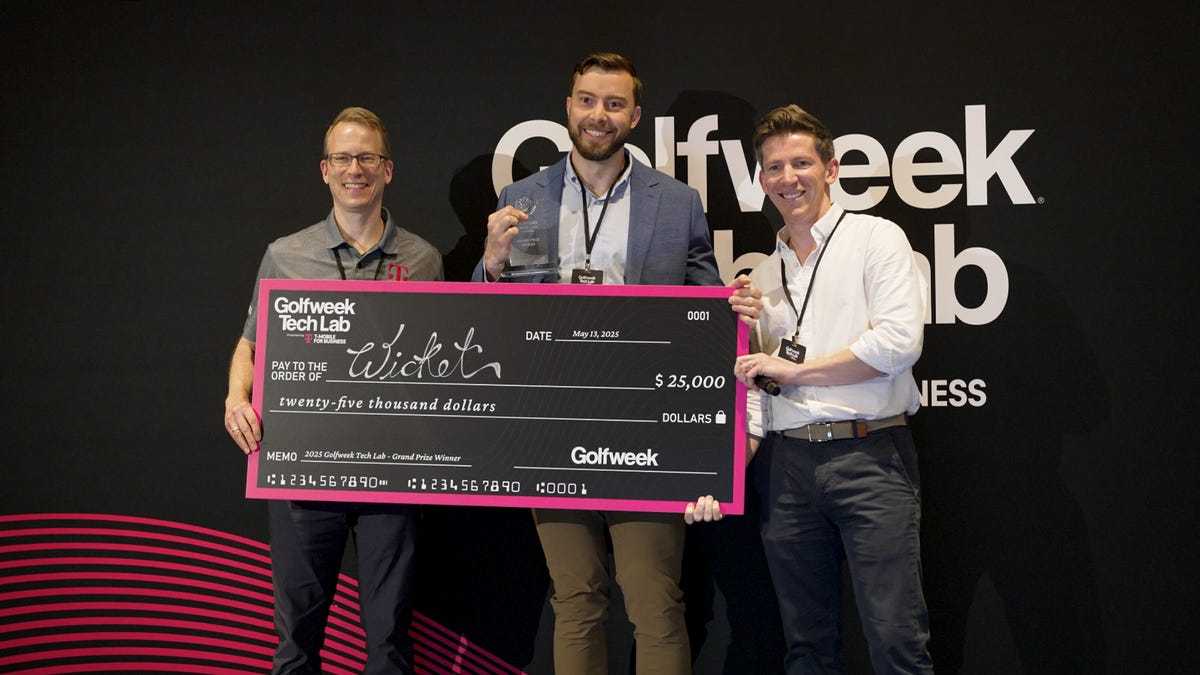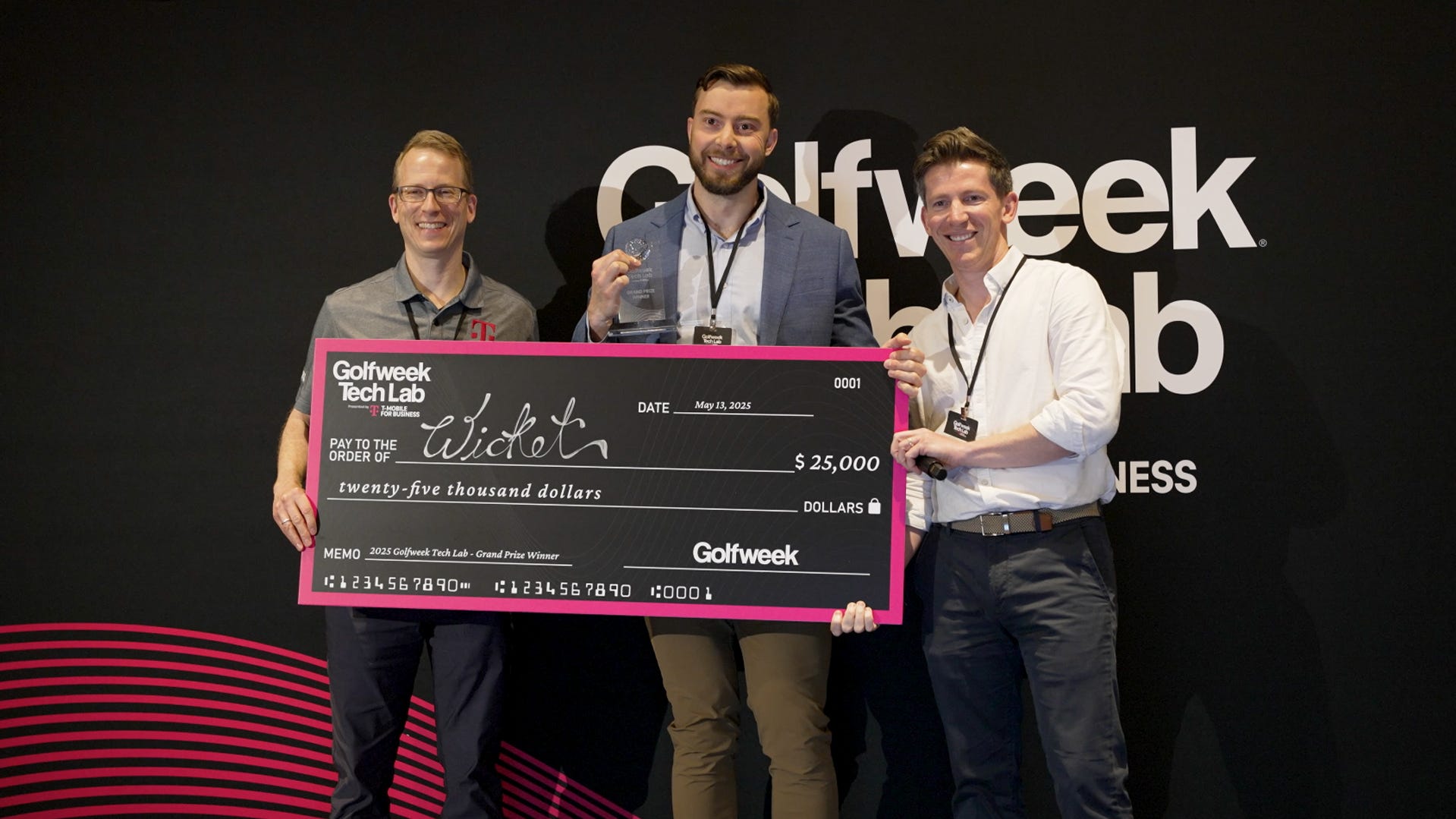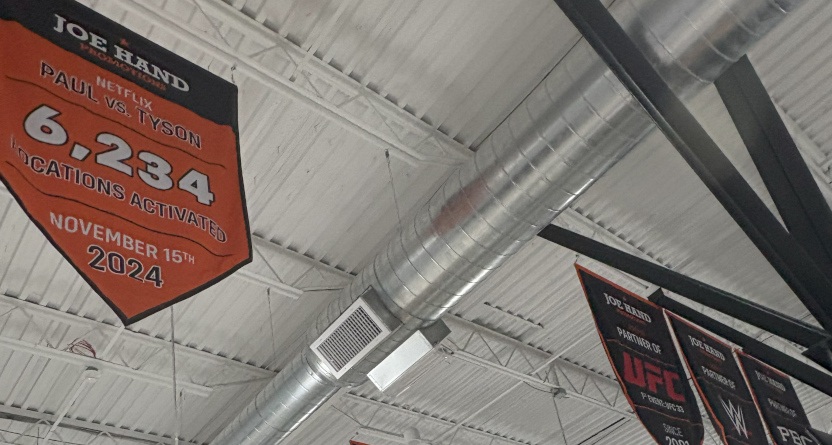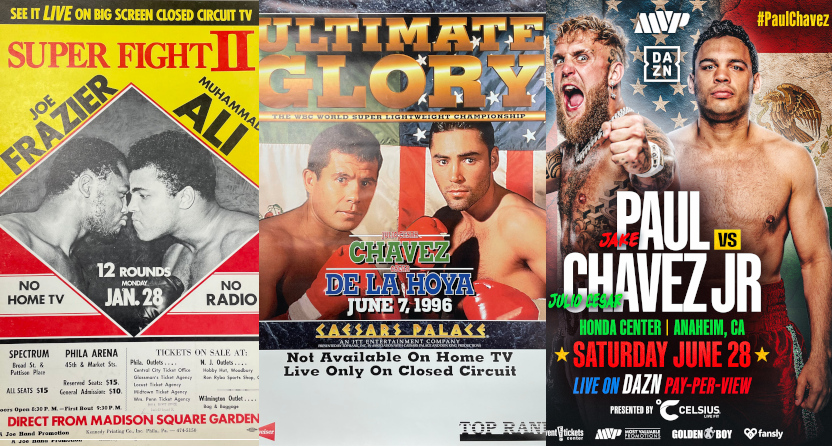Technology
Golfweek’s Tech Lab crowns Wicket as big winner
Wicket wins Golfweek Tech Lab grand prize Wicket’s facial authentication platform took home the $25K prize at Golfweek Tech Lab, presented by T-Mobile for Business. The 2nd annual Golfweek Tech Lab, presented by T-Mobile, was held in Charlotte. 18 startups competed for awards in five categories, plus a grand prize. Wicket, a facial recognition ticketing […]


Wicket wins Golfweek Tech Lab grand prize
Wicket’s facial authentication platform took home the $25K prize at Golfweek Tech Lab, presented by T-Mobile for Business.
- The 2nd annual Golfweek Tech Lab, presented by T-Mobile, was held in Charlotte.
- 18 startups competed for awards in five categories, plus a grand prize.
- Wicket, a facial recognition ticketing system, won the grand prize.
- Other category winners included VRTL, Platform Golf, and Play Anywhere.
If the first Golfweek Tech Lab, held in 2024 at the PGA of America’s new Frisco headquarters, proved the perfect starting point for a new festival focused on golf innovation, this year’s gathering in Charlotte — just days before the PGA Championship at Quail Hollow — cemented the event as a major player in the yearly golf calendar.
With 18 startups on site, the second annual event, again presented by T-Mobile for Business and produced by Golfweek and underdog venture team, included a session with Scott Gutterman, the PGA Tour’s SVP/digital and broadcast technologies.
“If you look back across the history of the sport, the sport has always evolved, the sport has always changed,” Gutterman said. “We will always uphold the tradition of the game, but we want to be looking forward. We want to be looking forward to what does golf mean to new and developing demographics.”
That sentiment was echoed by others at the conference, one that saw a guest panel of judges, including venture capitalists and business leaders from the world of golf. That group selected the winners of a best-in-show competition with participating companies hoping to earn recognition across five categories, as well as a grand prize. The judges evaluated each startup based on set criteria, including video submissions, onsite demonstration, and presentation to judges.
The winners were announced by T-Mobile’s SVP of Systems Realization Grant Castle.
The grand prize winner was Wicket, which uses facial recognition to scan people into sporting events by linking them with their tickets. According to its mission statement, Wicket features a “biometrics platform that enhances the experience for fans, guests, and employees while providing a smooth, seamless experience for clients and teams, allowing them to leverage existing assets effectively.”
The company is based in Massachusetts.
The category winners were:
- Fan Engagement: VRTL
- Athlete Performance: Platform Golf
- Digital & Media: Play Anywhere
- Business Solutions: Wicket
- 5G: Wicket
According to Nate Scott, the vice president and general manager of sports and events for Gannett, Golfweek’s Tech Lab was an unmitigated success.
“I’m delighted with our second year of Tech Lab. I’m a geek for this stuff, and seeing how entrepreneurs are imagining the future of the sport is always super exciting to see,” Scott said. “Golf has had a reputation for being set in its ways, yet I think there’s as much experimentation and innovation happening in the sport as any other.”
Technology
POV Camera Market Size, Share 2033
POV CAMERA MARKET OVERVIEW The global POV Camera market size expanded rapidly in 2022 and is projected to grow substantially by 2028, exhibiting a prodigious CAGR during the forecast period. The growth of the POV (Point of View) camera market is fueled by more people wanting to record videos hands-free for sports, adventure and professional […]

POV CAMERA MARKET OVERVIEW
The global POV Camera market size expanded rapidly in 2022 and is projected to grow substantially by 2028, exhibiting a prodigious CAGR during the forecast period.
The growth of the POV (Point of View) camera market is fueled by more people wanting to record videos hands-free for sports, adventure and professional events. People interested in sports, producing videos online and outdoor activities choose these compact cameras for the real-time footage they produce. The introduction of image stabilization, 4K resolution and waterproof designs is attracting more people to the camera market. Furthermore, having wireless connectivity and AI in place for managing content is making these products more attractive to users. With more people enjoying action sports, vlogging while traveling and using social media, the market continues to advance. Europe and North America are well-placed in the market due to their high earnings and use of technology, whereas adventure tourism and more smartphones are helping Asia Pacific grow at an amazing pace. Even though there are problems with costs and battery time, they are being solved as new technologies are introduced. To sum up, there will be a strong and increasing demand for POV cameras.
GLOBAL CRISES IMPACTING POV CAMERA MARKET
COVID-19 IMPACT
POV Camera Industry Had a Negative Effect Due to delays in project implementations during COVID-19 Pandemic
The global COVID-19 pandemic has been unprecedented and staggering, with the market experiencing lower-than-anticipated demand across all regions compared to pre-pandemic levels. The sudden market growth reflected by the rise in CAGR is attributable to the market’s growth and demand returning to pre-pandemic levels.
The COVID-19 pandemic had a major impact on the Point of View (POV) camera market thanks to many lockdowns and restrictions on going outdoors. The closure of manufacturing facilities caused supplies to be delayed and interrupted the supply chain. As tourism, adventure sports and recreational activities came to a stop, people did not buy POV cameras as much. Consumers bought fewer leisure products than basic goods because shops sold the latter first. Even so, interest in using wearable cameras for telemedicine and remote patient monitoring brought some benefit to the healthcare sector when other areas were slumping. Once there were fewer restrictions and people could go outside, the market started to grow again, with predictions of increased growth in the coming years.
LATEST TREND
Leveraging Edge Computing Integration to Propel Market Growth
The market for POV cameras is expanding rapidly because advancements in technology and greater demand for engaging videos are encouraging people to buy them. Recent POV cameras have 360-degree recording capability, can shoot in 4K and 8K resolution, have improved stability and longer battery time, all improving both video capture and viewing on-screen. Having voice control, streaming your videos live from the device and GPS tracking makes using POV cameras an enjoyable experience for users. More people creating and sharing on social media have contributed to the growth of POV cameras, as they look for new ways to share their stories. Because live streaming and VR are becoming more popular, POV camera applications have more potential uses.
POV CAMERA MARKET SEGMENTATION
BY TYPE
Based on Type, the global market can be categorized into CMOS Cameras, CCD Cameras.
● CMOS Cameras: The POV camera market can be categorized in CMOS cameras, which dominate because of its compact length, low energy consumption and excessive photograph first-rate. These cameras are extensively utilized in action, transmission and surveillance packages, boosting their adoption in client and expert segments worldwide.
● CCD Cameras: The POV digital camera market also can be labeled in CCD cameras. Better image is thought for best and low noise, CCD cameras are preferred in packages requiring high precision, such as medical imaging and industrial inspections, although their excessive cost and strength use limits are complete patron.
BY APPLICATION
Based on application, the global market can be categorized into Sports and Adventure, eSports, Defense and Security, Film and Television.
● Sports and Adventure: The Pov camera market may be classified in sports and adventures, in which those cameras are extensively used to catch an immersive, first-person method. Their durability, compact layout and excessive-resolution abilities lead them to best for activities together with biking, snowboarding, browsing and severe sports, growing the strong call for in this section.
● eSports: The global POV camera marketplace includes esports, in which the cameras are used to capture player reactions and gameplay from the first angle. This will increase the target audience engagement in stay streams and tournaments. The growing recognition of aggressive gaming continues to growth the demand for high -performing POV cameras within the subject.
● Defense and Security: The POV camera markets consist of Defense and Security, wherein those cameras provide actual -time monitoring, reconnaissance and status focus. Their compact length, durability and excessive-resolution imaging cause them to essential for military operations, law enforcement and border protection, driving has increased adoption in strategic and monitoring programs global.
● Film and Television: The POV camera markets encompass Film and Television, in which Pov cameras offer unique, immersive angles that boom storytelling. Dynamics, movement scenes and fact shows are used for dynamic shots, their mild and flexible design lets in filmmakers to capture authentic first-individual methods, boom creative production opportunities.
MARKET DYNAMICS
Market dynamics include driving and restraining factors, opportunities and challenges stating the market conditions.
DRIVING FACTORS
Rising Popularity of Adventure Sports and Outdoor Activities to Boost the Market
The rising interest in adventure sports and outdoor activities globally is pushing the POV camera market growth. Since mountain biking, skiing, surfing and hiking are becoming more popular, more people are buying durable and reliable compact wearable cameras. With these cameras, people can record exciting videos from first-person perspectives without ruining their adventure. POV cameras are a must for people who want to capture thrilling action without using their hands. Additionally, people are likely to continue adopting adventure travel due to the popularity of sharing their activities on social networks. As people enjoy recreation that is more active and involves experience, manufacturers add upgraded water resistance, stronger construction and improved stabilization to their products. On the whole, the positive influence of action sports on the market has encouraged both people to buy these cameras and made way for improvements in their technology.
Technological Advancements Enhancing User Experience to Expand the Market
The POV camera market is constantly progressing thanks to frequent technological advancements that enhance camera features and user convenience. With the help of 4K or 8K video and high-quality image stabilization, it’s easy to capture incredible footage even during fast-moving events. Better batteries give us longer recording time and reducing device size means greater comfort for those who record for a long time. Integrating voice control, GPS and wireless connectivity into cars makes them much easier to use and more attractive for everyone from casual drivers to those who use cars professionally. AI-enhanced features, including scene recognition, instant editing and tracking objects, increase what POV cameras can offer. By attracting more users and inspiring current users to improve their technology, these developments consistently grow the market. As the world of technology changes, more industries like sports, entertainment and businesses are expected to adopt POV cameras.
RESTRAINING FACTOR
High Cost of Advanced POV Cameras to Potentially Impede Market Growth
The expansion of the POV camera market is being hindered by different factors, despite more people wanting these products. The price of advanced POV cameras is often too high for consumers who are price-sensitive, especially in emerging countries. On top of that, batteries do not last long when recording for a long time which can make the cameras hard to use during extended sessions. Some people feel uneasy about being recorded all the time, so new rules have been introduced in different places. Besides, the market is very competitive, as smartphones are getting better with more of the same features, so many people don’t feel they need a separate camera. The limited number of uses restricts the number of people interested in standalone POV cameras. Those who casually use cameras can still stay away because extreme weather situations and the technical details of using these devices may seem off-putting. All of these factors make it more difficult for tech companies to gain ground in the market, though new advancements are starting to ease some of these problems.
OPPORTUNITY
Increasing Adoption in Professional Sectors to Create Opportunity for the Product in the Market
The market for POV cameras is expanding due to the increasing use of these cameras in various fields and advances in technology. More use in legal, medical and industrial areas creates additional market opportunities outside of sports and adventures. With more live streaming and virtual reality content now available, users are growing interested in hands-free methods for involving their audience in real time. As their incomes rise and people start to explore more and share on social media, emerging markets have massive, as-yet-unexplored potential. Because of AI, easy cloud use and upgraded battery life, modern cameras work well and make the devices more attractive. Learning how to team up with major smartphone brands and be part of wearables can help attract more users. Besides, a rising focus on remote jobs and training using wearable cameras is leading to new opportunities. All in all such opportunities will most likely ensure the POV camera market’s continued growth as it meets new requirements from consumers and businesses.
CHALLENGE
High Cost Associated with Advanced Features Could Be a Potential Challenge for Consumers
The challenges in the POV camera market prevent the market from reaching its fullest potential. The main point is that advanced features such as 4K, image stabilization and waterproofing are so expensive that many without the budget cannot enjoy them. The limited life of batteries causes difficulties, as users expect longer camera use without having to make the device bigger. The improvement in smartphone cameras is leading consumers away from standalone POV cameras. Companies also face issues with privacy and regulations due to concerns about consent and protecting data taken in public by these cameras. Setting up the camera and editing the captured images might be difficult for first-time users. Finally, shortages of products and challenges in the supply chain can also change the way products are available and how much they cost. Addressing these obstacles involves constantly brainstorming, cutting costs and openly talking about privacy to preserve customers’ trust and the company’s expansion.
POV CAMERA MARKET REGIONAL INSIGHTS
● NORTH AMERICA
North America leads the U.S POV camera market because people there can afford these products and technology is widespread. The area features many who take part in outdoor activities, sports and filmmaking, so there is high demand for accessories that take great video. Because of a large number of camera manufacturers and developers here, technology evolves and spreads quickly. Access to innovative models is made easy in North America because of the country’s established e-commerce platform. Because of its influence on social media and thriving legal and media fields, the region sees more interest in wearable cameras. Spending by government-funded projects is helping increase demand for ICT products. Yet, new privacy guidelines are being introduced, making it necessary for manufacturers to comply. Within North America, a focused population, strong economy and unique apps serves to make it extremely important for POV cameras.
● EUROPE
The POV camera market share is important in Europe due to its culture of sports, travel and outdoor activities. People in Germany, the UK and France are knowledgeable about wearable technology and look for products that improve their adventures and jobs. The area’s concentrate on quality, durability and new ideas leads manufacturers to design POV cameras that comply with tough standards set by regulations and the environment. With more enterprises using them, especially in law enforcement, healthcare and industrial areas, wearable cameras help make operations safer and clearer in Europe. In addition, people are more conscious about the environment which leads to using energy-efficient and sustainable equipment. Although GDPR is very strict, the increasing popularity of European brands and well-established distribution systems have helped the European market prosper. Both hobbyists and professionals use POV cameras in Europe, so it is an important market for POV camera companies.
● ASIA
The Asia Pacific region is rapidly emerging as a major growth market for POV cameras, increasing with increasing disposable income, increasing urbanization and expanding adventure tourism. Countries like China, India, Japan and South Korea are seeing growth in technical-loving youth consumers who embrace the technology wearing for sports, travel and social media materials. The large population base of the region offers huge unaccounted demand, encouraging manufacturers to provide cost-effective and convenient models to suit diverse consumer preferences. Additionally, an increase in e-commerce and smartphone penetration features widespread access to the wearable cameras. Asia Pacific Market is also benefiting from adopting enterprises availing cameras, including security, logistics, and manufacturing sectors, remote monitoring and training. Despite the challenges such as infrastructure inequalities and regulatory variations, it is in position as a promising range for the region’s dynamic economic growth and lifestyle trends to move the trend of lifestyle.
KEY INDUSTRY PLAYERS
Key Industry Players Shaping the Market Through Innovation and Market Expansion
Key players inside the POV Camera market drive innovation by developing advanced features like high-resolution video, photograph stabilization, and AI integration. They increase market attain via strategic partnerships, competitive pricing, and robust distribution networks, shaping consumer options and accelerating adoption across sports, expert, and industrial applications globally.
LIST OF TOP POV CAMERA COMPANIES
● Panasonic (Japan)
● Garmin (U.S)
● AIDA Imaging (U.S)
KEY INDUSTRY DEVELOPMENTS
June 2023: OMRON Corporation made an incredible advancement in the POV camera marketplace by using launching the MicroHAWK F440-F Smart Camera. This highly configurable five-megapixel industrial digital camera features a international shutter sensor, enhancing its competencies for diverse business programs.
REPORT COVERAGE
This report is based on historical analysis and forecast calculation that aims to help readers get a comprehensive understanding of the global POV Camera Market from multiple angles, which also provides sufficient support to readers’ strategy and decision-making. Also, this study comprises a comprehensive analysis of SWOT and provides insights for future developments within the market. It examines varied factors that contribute to the growth of the market by discovering the dynamic categories and potential areas of innovation whose applications may influence its trajectory in the upcoming years. This analysis encompasses both recent trends and historical turning points into consideration, providing a holistic understanding of the market’s competitors and identifying capable areas for growth. This research report examines the segmentation of the market by using both quantitative and qualitative methods to provide a thorough analysis that also evaluates the influence of strategic and financial perspectives on the market. Additionally, the report’s regional assessments consider the dominant supply and demand forces that impact market growth. The competitive landscape is detailed meticulously, including shares of significant market competitors. The report incorporates unconventional research techniques, methodologies and key strategies tailored for the anticipated frame of time. Overall, it offers valuable and comprehensive insights into the market dynamics professionally and understandably.
| Attributes | Details |
|---|---|
|
Market Size Value In |
US$ 1.2 |
|
Market Size Value By |
US$ 2.65 |
|
Growth Rate |
CAGR of to |
|
Forecast Period |
2024-2033 |
|
Base Year |
2024 |
|
Historical Data Available |
Yes |
|
Regional Scope |
Global |
|
Segments Covered |
Type & Application |
Technology
How Global Esports Tournaments are Driving Online Betting Growth
How Global Esports Tournaments are Driving Online Betting Growth Jun 27, 2025 Explore the connection between global esports tournaments and the surge in online betting, focusing on trends, technology, and key players. The Esports’ industry has experienced dramatic growth over the past decade, transforming from small-scale competitions into massive, internationally recognized tournaments. This […]

How Global Esports Tournaments are Driving Online Betting Growth

Jun 27, 2025
Explore the connection between global esports tournaments and the surge in online betting, focusing on trends, technology, and key players.
The Esports’ industry has experienced dramatic growth over the past decade, transforming from small-scale competitions into massive, internationally recognized tournaments. This evolution has been particularly evident in India, where a tech-savvy, youthful population has embraced competitive gaming on an unprecedented scale. Factors such as the proliferation of affordable smartphones, expanded access to high-speed internet, and the popularity of dedicated streaming platforms have enabled millions to become both players and spectators.
Games like PUBG Mobile, Valorant, and Dota 2 now headline tournaments with large prize pools, celebrity casters, and global sponsorships. These high-stakes events are extensively promoted on platforms like YouTube and Twitch, with dedicated Indian channels catering to the local audience. The excitement surrounding such competitions is matched by robust community engagement, with fans actively participating in online forums, meme culture, and fantasy leagues.
This growing ecosystem has also caught the eye of prominent sponsors, technology companies, and broadcast networks, which dedicate resources to supporting tournaments at both national and international levels. Young fans are forging communities both online and offline, gathering for viewing events or to analyze strategies of leading pro teams.
With this vibrant growth and engagement, esports has become an attractive market for online betting platforms. The opportunity to bet on favorite players or teams transforms passive viewership into an interactive experience, driving more fans to try their luck. The prominence of Indian teams in international events further fuels local enthusiasm and investment. By innovating to make betting solutions more user-friendly and accessible, companies have harnessed this momentum, positioning India as a burgeoning hub for esports and betting convergence.
1win’s Role in Esports Betting
Among the growing number of betting platforms in India, 1win distinguishes itself through its client-focused, modern approach. The company’s interface is sleek, intuitive, and optimized for both desktop and mobile users, making it approachable for newcomers while satisfying experienced bettors with its range of features and esports markets.
A standout aspect of 1win’s offering is its diversity users can place bets on live tournaments featuring games like CS2, Dota 2, and PUBG Mobile, as well as explore niche titles that are gaining in popularity. Coupled with competitive odds and frequent promotions, this variety appeals to an ever-widening audience seeking both excitement and value. Platform security is a priority, with encrypted transactions and multiple payment methods, including UPI, which is essential for Indian users.
To further amplify its appeal, one win regularly ramps up user engagement through loyalty programs, special event bonuses, and prompt payout mechanisms that cater directly to the expectations of Indian bettors. Its well-developed customer support and readily accessible educational resources help ensure that new users can confidently participate and make informed choices.
For serious bettors, 1win’s real-time analytics and match statistics allow for deeper insights, bringing a strategic edge to every wager. During high-profile tournaments, live updates let users react and adjust their bets instantly, increasing engagement and emotional investment in the outcome.
By focusing on technology, usability, and market relevance, 1win contributes to the broader surge in esports-based online betting in India. Its role in making global tournaments and markets readily available to Indian audiences highlights how industry leaders can set the pace for the sector’s continued expansion. Its commitment to continuous improvement is reflected in its evolving platform, designed to keep up with the rapidly changing esports landscape.
Why Esports Appeals to Bettors
Esports tournaments offer unique qualities that set them apart from traditional sports, making them particularly thrilling for the contemporary bettor. There are several major drivers behind esports’ popularity within the betting ecosystem:
- Year-Round Tournaments: Major and minor competitions span the calendar year, giving bettors constant action rather than the seasonal rhythms of many traditional sports.
- Variety of Games: From shooters and real-time strategy to sports simulations, the diversity allows bettors to specialize or experiment, keeping interest high.
- Mobile Accessibility: Betting on esports is optimized for smartphones, which dominate India’s tech landscape, allowing users to place bets from virtually anywhere.
- Interactive Services: Live streaming, data-rich dashboards, and in-play betting spice up the experience beyond simple win/loss wagers.
- Community Building: Indian esports fans often gather on Discord, Reddit, and other channels to share advice, predictions, and witty banter, creating a social fabric that sustains long-term engagement.
Broadcast innovation, social connectivity, and the thrill of unpredictable outcomes combine to ensure that esports betting enthusiasm isn’t a fleeting trend but a persistent and expanding phenomenon.
Global and Regional Trends in Esports Betting
Worldwide, esports betting has emerged as one of the fastest-growing segments in the online gaming industry. With the professionalism and production values of tournaments rivaling those of top-tier traditional sports leagues, the ecosystem has become an ideal landscape for betting companies to invest in and expand their offerings. High-profile events, such as the League of Legends World Championship or The International, draw millions of concurrent viewers and generate enormous betting volumes.
In regions like North America, Europe, and China, betting is increasingly legitimized and tightly integrated with major tournaments through official partnerships and broadcast sponsorships. These developments often bring a surge in media coverage, prize money, and legitimacy, setting the bar for global engagement.
In India, this growth trend is mirrored and amplified by the country’s huge, youthful demographic that already consumes gaming and media in digital-first formats. As more international tournaments recognize and court Indian audiences by offering local-language commentary, Asia-focused leagues, and India-specific tournaments, interest in both esports and betting continues to escalate.
Notably, the lack of clear regulations around esports betting acts both as an accelerator and a challenge. On one hand, the “gray area” regulatory environment grants Indian users easier access to numerous global platforms. On the other hand, it fuels debate about consumer protection and responsible betting. Increased investment from global gaming and tech brands, along with grassroots community advocacy, is further ensuring India’s stake in shaping the future of esports betting.
The Technology Behind Esports Betting
Behind the scenes, cutting-edge technologies are fueling the ascent of esports betting platforms and transforming the entire user experience. Artificial Intelligence and Machine Learning are used to provide sharper, more responsive odds and to analyze countless real-time variables during live matches, giving operators new ways to engage with their audience. These systems allow for predictive modeling and risk management that simply wasn’t possible a few years ago.
Developers are also leveraging big data analytics to refine marketing strategies, customize bonus programs, and tailor offers to individual bettor preferences. All of these technological advancements help in minimizing human error, improving fairness, and granting users a more dynamic, interactive experience.
Blockchain, meanwhile, addresses concerns about fairness and transparency in transactions. By using tamper-proof records, these decentralized systems build trust among users wary of fraud or manipulation, crucial in a relatively new and evolving industry. Payments are becoming instantaneous through fintech solutions like UPI, which is vital for a fast-moving Indian market used to on-demand service.
Augmented reality and immersive broadcasting technologies further enhance the way fans experience games and place bets, merging entertainment and interaction in exciting, novel ways. Streaming giants like YouTube Gaming and Twitch not only provide live video but are increasingly integrating betting widgets and overlays, making participation easier and more visually compelling.
Regulations and Ethical Concerns
Despite its undeniable popularity, esports betting in India faces significant regulatory and ethical hurdles. The current legal framework is ambiguous, often categorizing skill-based gaming and betting differently depending on the state. This regulatory vacuum means that companies and users must interpret where esports betting fits, which can lead to confusion and inconsistent consumer protections.
As operators and users navigate this environment, conversations around best practices and responsible gambling are increasingly important. Some regions within India have embraced forward-thinking licensing structures to regulate both online and offline gambling, while others maintain outright bans. This inconsistency is a persistent challenge for the industry.
There is also the ever-present concern of underage betting, as esports naturally attracts a younger demographic. Companies are under growing pressure to implement robust age verification systems and to provide educational resources about responsible gambling. Software solutions like self-exclusion tools, deposit limits, and cooldown periods are becoming more common in conscientious betting environments.
Collaborations between tournament organizers, platforms, and regulators are needed to foster a responsible, transparent environment. Clearer regulations, along with public awareness campaigns, will help safeguard young players and maintain long-term trust in the industry. The challenge for stakeholders is to walk the line between rapid industry growth and ensuring ethical responsibility, protecting vulnerable users from potential harms while supporting innovation and entrepreneurship.
The Future of Esports and Betting in India
India’s energetic embrace of both esports and online betting signals a future ripe with potential. Young audiences are not just passive consumers but active participants competing, streaming, and shaping culture through gaming. The steady rise of India-focused tournaments and esports organizations lays the groundwork for a mature, sustainable betting market.
As more Indian organizations field teams for international tournaments, the opportunity to support and engage with local talent only fuels interest and participation in both viewing and betting. Unique content offerings, such as regional broadcasts, viewer competitions, and grassroots esports events, are making competitive gaming and wagering more accessible to people across urban and rural regions alike.
Technologies like virtual reality and fully immersive platforms are on the horizon, promising to bring fans even closer to the action and potentially creating new avenues for interactive betting. With the requisite investments, regulatory clarity, and focus on user protection, India could well become a global leader in this dynamic field as betting and esports become even more intertwined.
As grassroots infrastructure expands and the regulatory environment evolves, the Indian esports betting sector appears ready for exponential growth, promising new opportunities for innovation, entrepreneurship, and broader societal impact.
Technology
How a newspaper article led to Joe Hand Promotions’ sports bar dominance
If you’re watching a boxing, UFC, wrestling, or other premium or pay-per-view event at a bar in North America, there’s a good chance Joe Hand Promotions played a role in that. The company is the largest North American distributor of premium sports programming to commercial establishments (bars, restaurants, casinos, and more), working with DirecTV, Dish, […]

If you’re watching a boxing, UFC, wrestling, or other premium or pay-per-view event at a bar in North America, there’s a good chance Joe Hand Promotions played a role in that. The company is the largest North American distributor of premium sports programming to commercial establishments (bars, restaurants, casinos, and more), working with DirecTV, Dish, cable, and streaming platforms, including DAZN for Saturday’s Jake Paul-Julio César Chávez Jr. fight. And they hit several high-water marks in 2024. But, as company president Joe Hand Jr. told Awful Announcing in a recent interview, that all stems from his father reading a newspaper article about Joe Frazier.
“He read an article in the Philadelphia Daily News one time where it said this group of prominent businessmen were starting a company called Cloverlay. And the purpose of that company was to manage the boxing career of this fighter that was coming back from the Olympics in 1964, Joe Frazier, with a gold medal and a broken thumb.
“And Joe trained right away. He had family and some kids, and he was trying to figure it out. And these six businessmen decided that they were going to put Joe on the payroll, and they were going to give him a paycheck every week, so all he would’ve had to do was worry about training to become the best fighter he could. Well, that story resonated with the Philadelphia sports fan and the Philadelphia newspapers, and they wrote the story.”
That article came at a notable time for the senior Joe Hand. He was a police officer in Philadelphia, but had been reassigned to an undesirable overnight gig patrolling the subway. When he read that article on Frasier, he wanted to get involved.
“My dad wrote a postcard to one of those principals, one of those six people,” Joe Hand Jr. said. “And when he wrote the postcard, remarkably, they got back to him. Dr. Baldwin owned a company called Baldwin Dairies. He was a very successful guy. And he said, ‘You’re in.’ He goes, ‘Come to the next meeting. We’d love to have a cop in. You have to bring $500 in, and we’ll see you at the next meeting. So my dad hangs up the phone, he’s stunned.
“And then he thinks to himself, ‘Damn, where am I going to get the 500 bucks? I don’t have it.’ He was making $7,500 a year as a cop. So he went to the police and fire credit union, borrowed the $500, showed up and became one of the first investors in Cloverlay.”
That company became a dramatic success in its own right, with Hand Jr. comparing his dad’s initial investment to buying early Apple stock at $10. But Hand Sr. then kept buying more stock, and having more time than the other principals, he took on a management role with Cloverlay.
“He became one of the biggest investors, he owned more, and he kept buying more and more stock,” Hand said. “But he said ‘I was getting the education of a lifetime.’ He had never gone to college, only graduated from high school, and he said, ‘I’m hanging around with all these really smart business guys, and you’d just have to be asleep not to get better.’
“And he was getting educated and they were coaching him and showing him and teaching him. So he actually became what I would call the business manager for Cloverlay, because the other guys were wealthy guys. They didn’t need another job. They wanted somebody to run the organization. And my dad became that guy.”
That paid off for Hand Sr. with Cloverlay, but Hand Jr. told AA the even bigger boost came from those other investors encouraging his father to start Joe Hand Promotions to handle closed-circuit TV broadcasts of Frazier’s fights.
“This whole idea of closed-circuit TV started, and they were like, ‘Joe, people are saying this could be a way for us to show our boxing events. Can you figure it out for us?’ He went to the library, he looked up closed circuit tv, and he came back and he goes, ‘Look, I think we can put a projector up in a movie theater, a high school gym, an auditorium, arenas around the country and sell tickets. And I think people will come.’
“And sure enough, he did it. And it became another way for at that time in the early seventies for people that were boxing fans to go and watch fights. I always call it the earliest form of pay-per-view tv. And it’s morphed into what it has along the way.”
“They made him start his own company, Joe Hand Promotions, to try to keep that business separate from the Cloverlay business. So almost reluctantly, they talked him into it. And they were coaching him up on how to run the business, on what to do. But my dad was a hardworking guy. He was a gambler, a true gambler, a gambler even with business. He took risks. And there were many times when they did those fights in the early years, he didn’t make money on some of them, and he was ready to quit.”
Despite some early struggles, Joe Hand Promotions established itself and got bigger and bigger, led by Joe Hand Sr. (who passed away last summer at 87, but remained involved in the company almost up to his death) and Jr. for that whole time. And what it has morphed into is indeed remarkable.
Joe Hand Promotions now works with national chains such as Buffalo Wild Wings and Dave & Buster’s, regional franchises such as Miller’s Ale House and Hops, and more than 10,000 independently owned and operated sports bars and restaurants. 2024 saw them hit all-time record marks in subscriptions for ESPN+ For Business, WWE, and DAZN Boxing, plus set an all-time commercial establishments record for a single event with 6,200 for Netflix’s Jake Paul-Mike Tyson fight. Here’s a look at some of its promotional posters over the years:

Joe Hand Promotions now has 50-plus employees, which is a long way from its beginnings. But Hand told AA he didn’t even want to get involved with it at first.
“I didn’t want to work in it. I really, really didn’t. The business has been around for 54 years and that means that at 67, I was just a teenager when literally the basement of our house was converted into an office. My father was there, and he and his sister, my aunt Pat, who’s 80 years old and still working here, were working in the basement of the house. And I’d come home from school and they’re like, ‘Hey, put your bag down. We need to get these press releases folded and labeled and stamped and get ’em out the door.’
“It didn’t sound real glamorous at the time. It didn’t feel that way. And so I graduated from a small school in Northeastern Pennsylvania, King’s College, and I came home. I had recently got engaged and my father asked me if I would help him out on a fight that he had gotten the rights to, which was Sugar Ray Leonard against Roberto Duran in the first fight in June of 1980.
“To be really honest, I knew that the business was in the house, but I never paid attention to it. I didn’t know what the hell they were doing. I knew they were down there making money, I guess, or whatever. Hopefully they were. But it didn’t matter to me.”
But Hand said he was willing to help out for that fight.
“So I went to work with my dad, and I told him I was going to do one fight. And he said, ‘Well, look, I’m going to make you my partner on this.’ I was like half paying attention. I knew I was getting a paycheck every week, which is great because I’m trying to get some money for a down payment on the deposit on a rental apartment or something.
“And when the fight was over, he came over and he gave me an envelope and he goes, ‘Here, this is yours.’ And I opened it up and there was this really a large check in there and I was like, ‘What’s this for?’ And he goes, ‘Well, that’s your share of the fight.’ I go, ‘Wait, I was getting paid, I got paid.’ He goes, ‘I told you you were my partner.’ I’m like, ‘Wow.’
“And he goes, ‘All right, now I know you only said one fight, but I do want to tell you this. They’re going to do a rematch in November, and I want to know, do you want to do two fights? Do the next one with me.’ And I paused and I looked at the check and I said, ‘Yeah, I want to do it because if I can get another check like that, it would be golden.’
Hand said that initial reluctance turned into a job he legitimately loves. And he said the company’s always been a family business.
“Although my mom’s name was never on the business, my mom was a big, big part of the success of the early years of our company, and frankly, even the later years. She just had a big voice in all of it. We truly are a family business. I used to say to my dad if he ever got mad at me and was looking across the desk, I’d go, ‘Hey, look, if you don’t like what you see here, there’s one person you should complain to. It’s you. Because I am what you created.’
For Hand, he’s thrilled to get to keep running this business his father created, and to keep working with family and friends.
“I think at 67 I have one regret and that regret is that I wish I was 47. The business is so much fun.
“It’s amazing that we are going through what we’re going through right now, which is a growth spurt as an industry and as a business. And damn, I just wish I was younger to be able to say I’m going to be around doing it, but I know it’s not going to work out that way.
“But I’ve got a wonderful group of people that are supporting me, people like Chris [DeBlasio, communications consultant] and Tim [McManus, senior director of content and partnerships], and we’ve got nieces and nephews and cousins and a bunch of people working here on our staff of 50 people. And it is just a fun, sexy business to be working in when, in all honesty, you’re the best at it. We are. And it really is fun coming to work every day.”

Remarkably, though, while boxing has been key for JHP over the years, Hand said his interests were in a much different sport to start with. That would be basketball, where he even was a NBA draft pick.
“I had no interest in boxing. I actually was a basketball fan and player. I was lucky enough in 1980 to get drafted by the Philadelphia 76ers in the 10th round. Basketball was my sport and I loved doing it.
“Boxing only came into the Hand family because of my dad’s relationships, born out of investing in Cloverlay. …I think we all grew to become fonder of it as the years went by, because we were in it and we were watching it. And we all loved Joe Frazier and all the opportunities that our relationship with Joe gave us as a family.”
Hand said those early connections with Frazier led to the company being mostly known for boxing at first, but they’ve grown well beyond that. One huge move for them was an early partnership with the UFC.
“People would say, ‘Hey, Joe Hand Promotions, you’re the fight guys.’ And you know what? They were accurate. That’s who we were. Not only for our roots being in the boxing business with the Joe Frazier connection first and then just over the decades of doing all the boxing events, but then in 2001, Dana White and his friends, the Fertitta brothers take over the UFC and we start a relationship there.
“As Dana likes to tell everybody, we’re the longest-tenured vendor that they have in their company. We’ve been there since really the day that he bought the company. And we would love to be there until the day he sells it and goes on his merry way.”
While Joe Hand Promotions is still in the business of distributing content to sports bars and other locations, that business has changed a lot. Hand said the key recent shift there is about streaming-only events.
“I told my dad probably about eight, seven or eight years ago, I said, ‘Dad, I’m going to tell you this streaming phenomenon is going to come and our business is going to get impacted by it.’ If you took a look at the timeline of this company, we were always on the timeline in some kind of change due to technology, whether it was close circuit tv, and then all of a sudden our world changes when DirecTV comes into it and they’re like, ‘Yeah, you can put these little pizza pie dishes on the lens of your apartment and you can bring the signal in.’ You’re going ‘No way. That’s not going to work.’ Yes, it did. And then now we are on the cusp of streaming.”
“I think the one thing I miscalculated in all of that was I thought that streaming was going to change the way we deliver the signal to the bar owners. That’s true. But it’s not happening as fast as it is with the consumer. But the thing that I wasn’t planning on was that streaming was going to create so many new content partners for us.”
Hand said the streaming era’s been a huge boost for his company, expanding their partnerships and what they can offer to their customers.
“I just never knew that we were going to start doing business with DAZN, ESPN+, AEW, Netflix, all these companies that now are like tech companies. And all it’s done is create, for Joe Hand Promotions, a bigger menu of programming to resell to those bars and restaurants, because they want the programming. I mean, ESPN+, the first month that we launched them, when they were in their infancy, I think they had 43,000 unique events in one month. Holy smokes, I’m like, ‘I can’t believe this. We were working fight to fight.’
“UFC fights, we’d have 12 in a year, we’d have four or five or six big boxing events in a year. I mean, it’s incredible the amount of sports that’s out there. And if you’re a sports bar and you have TVs and you want content, boy, it’s pretty sure that now we can deliver it to you.’
And Hand said he thinks there will be demand for watching sports at bars well into the future, citing the way he often goes out with friends to watch Eagles’ games and other sports events.
“I think that there is going to always be that need for a communal experience in Philly,” Hand said. “It’s fun. What can you say that’s not fun about something like that? My wife’s happy because the house doesn’t get all messed up with popcorn all over, with us making loud noise, and she loses part of her house.
“But I think that people just generally love to have that communal experience. And when they do, what we give those bar owners is that unique content that’s not available on every TV station. And that’s what’s going to make them separate themselves competitively from the guy next door.”
Technology
GEF’s Global Progress in the Year of Development
GEF CEO Paul J. Foster reflects on the first half of 2025—spotlighting key milestones, new frontiers, and a shared vision for the future of global esports By Paul J. Foster, CEO, Global Esports Federation Paul J. Foster (right)—interview with Guy Shone, AnewZ, in Baku, Azerbaijan As we reach the midpoint of 2025, the Global Esports […]

GEF CEO Paul J. Foster reflects on the first half of 2025—spotlighting key milestones, new frontiers, and a shared vision for the future of global esports
By Paul J. Foster, CEO, Global Esports Federation
As we reach the midpoint of 2025, the Global Esports Federation continues to deliver on our mission to grow, connect, and innovate across the global esports landscape. Guided by our Year of Development framework, we’ve focused on expanding opportunities for players, partners, and our #worldconnected community.
This first half of the year has been defined by purposeful action—driven by the collective efforts of our global network. We are strengthening our foundation, unlocking new potential, and laying the groundwork for a sustainable future for esports.
Expanding the Global Circuit
Our events portfolio continues to evolve, powered by new host cities and deepening collaborations with our Member Federations and partners. As part of the expanded Global Esports Tour (GET), upcoming Season 5 stops in Lima and Mumbai mark significant milestones for Latin America and South Asia—regions where passionate communities and rich cultures shape the future of esports.
Our events are designed to be more than competitions—they’re experiences that reflect the spirit of inclusion and the global nature of our movement.
Planning is also underway for Season 6, as we explore new and exciting destinations to grow the global circuit.
In Africa, the second edition of the African Esports Championships: Southern Africa Region (#AEC25) will take place in Windhoek, Namibia, alongside the AUSC Region 5 Youth Games. Delivered in partnership with the African Esports Development Federation (AEDF) and the Africa Union Sports Council (AUSC) Region 5, this year’s edition will spotlight eFootball™ and Street Fighter 6—offering a high-impact platform for emerging talent and deepening regional connection.
Looking Ahead to Lima
As momentum builds, we continue to work closely with our partners in Peru in anticipation of the Lima 2025 Global Esports Games—our fourth edition of this flagship event. #GEG25 is envisioned as a celebration of elite competition, cultural exchange, and meaningful global connection.
We’re encouraged by the strong support from the Government of Peru and remain committed to shaping a memorable experience with and for our community. While final details are being finalized, we invite our #worldconnected family to stay engaged as we prepare for this next chapter.
At the same time, our team is in advanced discussions with the host cities for the Global Esports Games 2026.
Empowering Youth and Ensuring Safe Play
This year, we deepened our commitment to youth through purpose-driven partnerships. A key highlight: welcoming GAKU as a Global Impact Partner. Together, we’re delivering programs that combine esports, education, and creativity—equipping young people with the tools to thrive in the digital age.
The most meaningful progress happens when values align. These partnerships allow us to drive real impact—especially where it matters most.
We also launched the International Safeguards for Children in Esports, in collaboration with British Esports, Canterbury Christ Church University, and the International Safeguards for Children in Sport. This global framework sets a new benchmark for safe, inclusive, and positive participation—aligned with international best practices and grounded in the rights of children.
Advancing Health and Wellness in Esports
Our commitment to athlete well-being continues to guide our work with global partners. Through the leadership of our Vice President and Chair of the Health and Wellness Commission, Dr. Melita N. Moore, GEF has contributed to the development of the World Health Organization’s Global Standard for Safe Listening in Video Gameplay and Esports. This evidence-based standard outlines design features for both gameplay software and hardware that can reduce the risk of hearing loss among players. Dr. Moore has represented the GEF across WHO-led consultations on Make Listening Safe, reinforcing our shared mission to support a safe, sustainable, and health-conscious esports ecosystem.
Strengthening Global Connections
Our long-term partnership with the Azerbaijan Esports Federation continues to grow. Recent high-level meetings with the National Olympic Committee of Azerbaijan have laid the groundwork for future GEF events and deeper regional integration.
From sport to esports, from strategy to action—the momentum is real. Azerbaijan is ready.
While in Baku, I also joined Editor in Chief, Guy Shone on AnewZ for a wide-ranging conversation on the future of esports, global unity, and what’s next for our #worldconnected community—amplifying our vision on the international stage.
At Web Summit Vancouver — GEF CEO Paul J. Foster joins leaders across sport, tech, and innovation to explore the future of esports. From Opening Night to the “Future of Esports” panel, the Summit sparked real conversations and reaffirmed the power of connection, presence, and purpose in shaping what’s next. #worldconnected
We’re seeing renewed momentum behind the Global Innovation and Research Centers (IRCs)—a long-envisioned strategic initiative to establish regional hubs in key locations around the world. Designed to harness the power of technology, creativity, and innovation, the IRCs aim to unlock human potential in the digital era. Discussions are actively progressing to establish the first IRC in Southern Europe. As a natural extension of our GEF*lab incubation system, these centers will serve as engines for innovation and collaboration, cultivating sustainable partnerships across national, regional, and international levels.
A Shared Journey, A Connected Future
As we race into the second half of 2025, our focus remains on continuity—scaling what works, deepening regional engagement, and preparing for the milestones ahead.
Development is a continuous process. We’re inspired every day by the energy of our community and the opportunities ahead. With collaboration, creativity, and courage, we’re shaping a future of esports that belongs to everyone.
Technology
Trump says he’s terminating trade talks with Canada over tax on technology firms
President Donald Trump says the United States will suspend trade negotiations with Canada after Canada implemented a digital services tax on U.S. based companies. Trump wrote on social media that because Canada has chosen to implement a tax on U.S.-based digital services, the U.S. would be ending trade discussion. “Based on this egregious Tax, we […]

President Donald Trump says the United States will suspend trade negotiations with Canada after Canada implemented a digital services tax on U.S. based companies.
Trump wrote on social media that because Canada has chosen to implement a tax on U.S.-based digital services, the U.S. would be ending trade discussion.
“Based on this egregious Tax, we are hereby terminating ALL discussions on Trade with Canada, effective immediately. We will let Canada know the Tariff that the will be paying to do business with the United States of America within the next seven day period.”
The 3% tax will apply to revenue that U.S. tech companies generate from Canadian users. It applies retroactively, meaning companies like Apple, Google and Netflix will owe Canada $2 billion for services already rendered through June.
RELATED STORY | Tariff engineering: The legal way companies avoid paying higher import taxes
A White House official told Scripps News the decision aligned with policies set out in a memorandum from President Trump on February 21.
“My Administration will not allow American companies and workers and American economic and national security interests to be compromised by one-sided, anti-competitive policies and practices of foreign governments. American businesses will no longer prop up failed foreign economies through extortive fines and taxes,” the memorandum reads.
Scripps News has reached out to the White House for further comment.
“Digital Services Taxes are designed to unfairly target U.S. tech companies — punishing American innovation and costing our economy and companies tens of billions,” Commerce Secretary Howard Lutnick wrote. “Why do countries think they can attack our technology companies and then turn around and try to take advantage of our 30 Trillion dollar economy?”
Technology
Disney target raised at Guggenheim on sports, parks momentum
Investing.com — Guggenheim raised its price target on Walt Disney (NYSE:DIS) Co to $140 from $120 on stronger-than-expected trends across sports advertising, theme parks, and progress on cost-cutting as the company pushes toward a more unified streaming strategy. The brokerage maintained its Buy rating and now expects Disney’s segment operating income to reach $17.7 billion […]

Investing.com — Guggenheim raised its price target on Walt Disney (NYSE:DIS) Co to $140 from $120 on stronger-than-expected trends across sports advertising, theme parks, and progress on cost-cutting as the company pushes toward a more unified streaming strategy.
The brokerage maintained its Buy rating and now expects Disney’s segment operating income to reach $17.7 billion in fiscal 2024, slightly ahead of consensus at $17.65 billion.
That includes a lift in fiscal third-quarter operating income to $4.5 billion from a previous $4.4 billion forecast.
Invest in Gold
Powered by Money.com – Yahoo may earn commission from the links above.
Guggenheim said its updated model reflects better profitability in Disney’s Linear Networks business after the Star India exit, higher-margin sports ad revenue during the seven-game NBA Finals, and more resilient park attendance and travel trends than previously forecast.
While recent films like Elio and Thunderbolts underperformed at the box office, the impact was partly offset by stronger expectations for the Lilo & Stitch remake.
Content licensing and theatrical revenue was trimmed, but Disney’s direct-to-consumer (DTC) earnings forecast was unchanged and remained above Wall Street estimates.
On the Sports side, the firm noted an increase in total viewership for the NBA Finals despite lower ratings per game. That pushed ad revenue estimates up, helping segment operating income reach $1 billion.
Theme park demand remained solid, with Guggenheim citing improving app engagement trends for both domestic and international parks.
Daily downloads declined less sharply in the U.S. and returned to growth overseas in the June quarter, according to the note.
Guggenheim said Disney’s full control of Hulu and the upcoming ESPN streaming launch set the stage for more aggressive bundling, positioning the company well to grow digital revenues amid a shift away from traditional TV.
The firm’s new price target is based on a 23.8x multiple of 2025 earnings, reflecting confidence in long-term growth in digital and parks operations.
Related articles
Disney target raised at Guggenheim on sports, parks momentum
Nvidia acquires Canadian AI startup CentML – The Logic
Piper makes Meta its top large-cap pick, lifts price view on AI-driven ad gains
-

 Motorsports2 weeks ago
Motorsports2 weeks agoNASCAR Weekend Preview: Autódromo Hermanos Rodríguez
-

 Motorsports2 weeks ago
Motorsports2 weeks agoNASCAR Through the Gears: Denny Hamlin has gas, a border needs crossing, and yes, that’s a Hemi
-

 Health2 weeks ago
Health2 weeks agoGymnast MyKayla Skinner Claims Simone Biles 'Belittled and Ostracized' Her amid Riley …
-

 High School Sports3 weeks ago
High School Sports3 weeks agoHighlights of the Tony Awards
-

 Motorsports2 weeks ago
Motorsports2 weeks agoNASCAR Race Today: Mexico City start times, schedule and how to watch live on TV
-

 Professional Sports3 weeks ago
Professional Sports3 weeks agoUFC 316
-

 NIL2 weeks ago
NIL2 weeks agoTennessee law supersedes NCAA eligibility rule
-

 College Sports3 weeks ago
College Sports3 weeks agoFisk to discontinue history-making gymnastics program after 2026 | Area colleges
-

 Sports2 weeks ago
Sports2 weeks agoCoco Gauff, The World's Highest
-

 Social Media2 weeks ago
Social Media2 weeks agoPune Athletes Make Global Mark at IRONMAN Hamburg and Brazil 2025



































